All Exams >
ACT >
Science for ACT >
All Questions
All questions of Organic Chemistry for ACT Exam
The organic compound given below is one of the four options given below. Choose the most appropriate one. 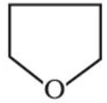
- a)aromatic heteroyclic compound
- b)aliphatic heteroyclic compound
- c)alicyclic compound
- d)ring compound
Correct answer is option 'B'. Can you explain this answer?
The organic compound given below is one of the four options given below. Choose the most appropriate one.
a)
aromatic heteroyclic compound
b)
aliphatic heteroyclic compound
c)
alicyclic compound
d)
ring compound

|
Rohit Joshi answered |
this is aliphatic heterocyclic compound.
Which is true about conformers of 1,1,2,2-tetrachloroethane?Which is true about conformers of 1,1,2,2-tetrachloroethane?
a) The most stable conformer has dihedral angle of 60° between all adjacent chlorine atoms
b) In the least stable conformer, two Cl-atoms are eclipsing one another while other two Cl-atoms are eclipsed to hydrogen atoms
c) In the most stable conformer, dihedral angle between hydrogen atoms is 60°
d) The most stable conformer is non-polar - a)The most stable conformer has dihedral angle of 60° between all adjacent chlorine atoms
- b)In the least stable conformer, two Cl-atoms are eclipsing one another while other two Cl-atoms are eclipsed to hydrogen atoms
- c)In the most stable conformer, dihedral angle between hydrogen atoms is 60°
- d)The most stable conformer is non-polar
Correct answer is option 'D'. Can you explain this answer?
Which is true about conformers of 1,1,2,2-tetrachloroethane?
Which is true about conformers of 1,1,2,2-tetrachloroethane?
a) The most stable conformer has dihedral angle of 60° between all adjacent chlorine atoms
b) In the least stable conformer, two Cl-atoms are eclipsing one another while other two Cl-atoms are eclipsed to hydrogen atoms
c) In the most stable conformer, dihedral angle between hydrogen atoms is 60°
d) The most stable conformer is non-polar
a) The most stable conformer has dihedral angle of 60° between all adjacent chlorine atoms
b) In the least stable conformer, two Cl-atoms are eclipsing one another while other two Cl-atoms are eclipsed to hydrogen atoms
c) In the most stable conformer, dihedral angle between hydrogen atoms is 60°
d) The most stable conformer is non-polar
a)
The most stable conformer has dihedral angle of 60° between all adjacent chlorine atoms
b)
In the least stable conformer, two Cl-atoms are eclipsing one another while other two Cl-atoms are eclipsed to hydrogen atoms
c)
In the most stable conformer, dihedral angle between hydrogen atoms is 60°
d)
The most stable conformer is non-polar
|
|
Mira Joshi answered |
The correct answer is option D
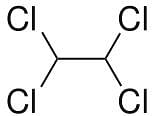
This molecule is non-polar two Cl atoms in one carbon atom cancel the polarity other two Cl atoms on the next carbon.
Also all the Cl atoms are at max distance from each other so max. Stability due to less repulsion between Cl atoms. Dihedral angle between H and Cl is 60°

This molecule is non-polar two Cl atoms in one carbon atom cancel the polarity other two Cl atoms on the next carbon.
Also all the Cl atoms are at max distance from each other so max. Stability due to less repulsion between Cl atoms. Dihedral angle between H and Cl is 60°
Pick the odd one out:- a)Napthalene
- b)Sodium chloride
- c)Ammonium chloride
- d)Camphor
Correct answer is option 'B'. Can you explain this answer?
Pick the odd one out:
a)
Napthalene
b)
Sodium chloride
c)
Ammonium chloride
d)
Camphor

|
Rakesh Kumar answered |
Three are covalently bonded but NaCl is purely ionic compound
Which among the following is not an aromatic compound(in specific)- a)Naphthalene
- b)Aniline
- c)Pyridine
- d)Tropolone
Correct answer is option 'C'. Can you explain this answer?
Which among the following is not an aromatic compound(in specific)
a)
Naphthalene
b)
Aniline
c)
Pyridine
d)
Tropolone

|
Sai Mishra answered |
Pyridine is heterocyclic aromatic compound. Whereas naphthalene and aniline are benzenoid aromatic compounds and tropolone is a non-benzenoid aromatic compound.
Which of the following is the correct IUPAC name?
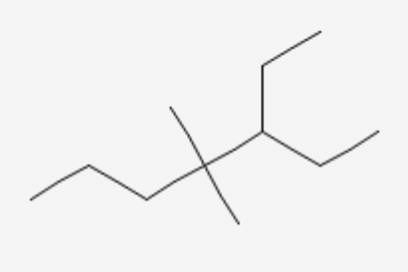
- a)5-Ethyl-4, 4-dimethylheptane
- b)4, 4-Dimethyl-3-ethylheptane
- c)3-Ethyl-4, 4-dimethylheptane
- d)4, 4-Bis(methyl)-3-ethylheptane
Correct answer is option 'C'. Can you explain this answer?
Which of the following is the correct IUPAC name?


a)
5-Ethyl-4, 4-dimethylheptane
b)
4, 4-Dimethyl-3-ethylheptane
c)
3-Ethyl-4, 4-dimethylheptane
d)
4, 4-Bis(methyl)-3-ethylheptane
|
|
Raghav Bansal answered |
While writing IUPAC name, the alkyl groups are written in alphabetical order. Thus lower locant 3 is assigned to ethyl. Prefix, di, tri, and tetra are not included in alphabetical order.
Organic compounds are broadly classified as
- a)alicyclic compounds and acyclic compounds
- b)Open chain compounds and linear chain compounds
- c)Cyclic compounds and alicyclic compounds
- d)Open chain compounds and closed compounds
Correct answer is option 'D'. Can you explain this answer?
Organic compounds are broadly classified as
a)
alicyclic compounds and acyclic compounds
b)
Open chain compounds and linear chain compounds
c)
Cyclic compounds and alicyclic compounds
d)
Open chain compounds and closed compounds

|
Arpita Nambiar answered |
The correct answer is option D
Organic compounds are broadly classified into open chain and closed chain compounds. Explanation: open chain compounds or acyclic compounds are otherwise called as aliphatic compounds.
Organic compounds are broadly classified into open chain and closed chain compounds. Explanation: open chain compounds or acyclic compounds are otherwise called as aliphatic compounds.
Which is not true regarding conformers of ethane?- a)Theoretically infinite conformers exist
- b)Staggered conformer has lower torsional strain than eclipsed one
- c)Increasing temperature increases the percentage of eclipsed conformer
- d)By precise experimental setup, staggered conformer can be separated out of system
Correct answer is option 'D'. Can you explain this answer?
Which is not true regarding conformers of ethane?
a)
Theoretically infinite conformers exist
b)
Staggered conformer has lower torsional strain than eclipsed one
c)
Increasing temperature increases the percentage of eclipsed conformer
d)
By precise experimental setup, staggered conformer can be separated out of system
|
|
Neha Joshi answered |
The correct answer is Option D.
Although conformers differ in potential energy and stability, the difference is so small that it does not allow their practical separation.
Although conformers differ in potential energy and stability, the difference is so small that it does not allow their practical separation.
Write the state of hybridisation of carbon in H2C=O.- a)sp3 hybridised carbon, trigonal
- b)sp2 hybridised carbon, trigonal planar
- c)sp3 hybridised carbon, tetrahedral
- d)sp hybridised carbon, linear
Correct answer is option 'B'. Can you explain this answer?
Write the state of hybridisation of carbon in H2C=O.
a)
sp3 hybridised carbon, trigonal
b)
sp2 hybridised carbon, trigonal planar
c)
sp3 hybridised carbon, tetrahedral
d)
sp hybridised carbon, linear
|
|
Geetika Shah answered |
C in H2C=O is sp2 hybridised and geometry is planar.
Nitration of benzene is:- a)Free radical substitution reaction
- b)Nucleophilic addition reaction
- c)Nucleophilic substitution reaction
- d)Electrophilic substitution reaction
Correct answer is option 'D'. Can you explain this answer?
Nitration of benzene is:
a)
Free radical substitution reaction
b)
Nucleophilic addition reaction
c)
Nucleophilic substitution reaction
d)
Electrophilic substitution reaction
|
|
Arun Khanna answered |
Nitration and sulfonation of benzene are two examples of electrophilic aromatic substitution. The nitronium ion (NO2+) and sulfur trioxide (SO3) are the electrophiles and individually react with benzene to give nitrobenzene and benzenesulfonic acid respectively.
Impure sample of Naphthalene can be purified by:- a)Distillation
- b)Chromatography
- c)Crystallisation
- d)Sublimation
Correct answer is option 'D'. Can you explain this answer?
Impure sample of Naphthalene can be purified by:
a)
Distillation
b)
Chromatography
c)
Crystallisation
d)
Sublimation
|
|
Vijay Bansal answered |
Impure sample of Naphthalene can be purified by Sublimation.
This apparatus provides many surfaces for heat exchange between the ascending vapours and the descending condensed liquid.
- a)Round bottom flask
- b)Pipette
- c)Burette
- d)Fractionating column
Correct answer is option 'D'. Can you explain this answer?
This apparatus provides many surfaces for heat exchange between the ascending vapours and the descending condensed liquid.
a)
Round bottom flask
b)
Pipette
c)
Burette
d)
Fractionating column
|
|
Anand Kapoor answered |
**Explanation:**
The correct answer is option D, the fractionating column. Let's break down the explanation:
**1. Heat Exchange:**
The apparatus mentioned in the question is designed to facilitate heat exchange between ascending vapors and descending condensed liquid. Heat exchange is an essential process that occurs in various applications, such as distillation, where it helps in separating mixtures based on differences in boiling points.
**2. Surfaces for Heat Exchange:**
The apparatus should provide multiple surfaces or stages where heat exchange can occur. This means that the ascending vapors and descending condensed liquid should come into close contact with each other, allowing thermal energy transfer.
**3. Round Bottom Flask, Pipette, and Burette:**
The options A (round bottom flask), B (pipette), and C (burette) do not meet the criteria for providing multiple surfaces for heat exchange. Let's briefly explain why:
- **Round Bottom Flask (Option A):** A round bottom flask is a commonly used laboratory glassware that is primarily used for holding liquids and conducting chemical reactions. It does not provide multiple surfaces for heat exchange as required in the question.
- **Pipette (Option B):** A pipette is a laboratory tool used for accurately measuring and transferring small volumes of liquids. It is not designed for heat exchange between ascending vapors and descending condensed liquid.
- **Burette (Option C):** A burette is a long, graduated glass tube with a stopcock at the bottom. It is commonly used in titrations for precise volume measurements but does not provide the required surfaces for heat exchange.
**4. Fractionating Column (Option D):**
The fractionating column is a specially designed apparatus used in distillation processes to achieve separation of liquid mixtures based on differences in boiling points. It consists of multiple stages or trays, providing numerous surfaces for heat exchange.
- **Heat Exchange in the Fractionating Column:** As the vapor rises through the fractionating column, it comes into contact with the descending condensed liquid. Heat is exchanged between the ascending vapors and the descending liquid, allowing the separation of components with different boiling points.
- **Multiple Surfaces for Heat Exchange:** The fractionating column contains several trays or stages, each acting as a surface for heat exchange. The vapors and condensed liquid interact on these trays, promoting efficient heat transfer between the two phases.
Therefore, the fractionating column is the apparatus that best fits the description provided in the question, offering multiple surfaces for heat exchange between ascending vapors and descending condensed liquid.
The correct answer is option D, the fractionating column. Let's break down the explanation:
**1. Heat Exchange:**
The apparatus mentioned in the question is designed to facilitate heat exchange between ascending vapors and descending condensed liquid. Heat exchange is an essential process that occurs in various applications, such as distillation, where it helps in separating mixtures based on differences in boiling points.
**2. Surfaces for Heat Exchange:**
The apparatus should provide multiple surfaces or stages where heat exchange can occur. This means that the ascending vapors and descending condensed liquid should come into close contact with each other, allowing thermal energy transfer.
**3. Round Bottom Flask, Pipette, and Burette:**
The options A (round bottom flask), B (pipette), and C (burette) do not meet the criteria for providing multiple surfaces for heat exchange. Let's briefly explain why:
- **Round Bottom Flask (Option A):** A round bottom flask is a commonly used laboratory glassware that is primarily used for holding liquids and conducting chemical reactions. It does not provide multiple surfaces for heat exchange as required in the question.
- **Pipette (Option B):** A pipette is a laboratory tool used for accurately measuring and transferring small volumes of liquids. It is not designed for heat exchange between ascending vapors and descending condensed liquid.
- **Burette (Option C):** A burette is a long, graduated glass tube with a stopcock at the bottom. It is commonly used in titrations for precise volume measurements but does not provide the required surfaces for heat exchange.
**4. Fractionating Column (Option D):**
The fractionating column is a specially designed apparatus used in distillation processes to achieve separation of liquid mixtures based on differences in boiling points. It consists of multiple stages or trays, providing numerous surfaces for heat exchange.
- **Heat Exchange in the Fractionating Column:** As the vapor rises through the fractionating column, it comes into contact with the descending condensed liquid. Heat is exchanged between the ascending vapors and the descending liquid, allowing the separation of components with different boiling points.
- **Multiple Surfaces for Heat Exchange:** The fractionating column contains several trays or stages, each acting as a surface for heat exchange. The vapors and condensed liquid interact on these trays, promoting efficient heat transfer between the two phases.
Therefore, the fractionating column is the apparatus that best fits the description provided in the question, offering multiple surfaces for heat exchange between ascending vapors and descending condensed liquid.
 Among these compounds, the correct order of resonance energy is
Among these compounds, the correct order of resonance energy is- a)I > II > III
- b)III > II > I
- c)II > III > I
- d)II > I > III
Correct answer is option 'C'. Can you explain this answer?
Among these compounds, the correct order of resonance energy is
a)
I > II > III
b)
III > II > I
c)
II > III > I
d)
II > I > III
|
|
Shiva Reddy answered |
Resonance energy is directly proportional to stability
 C1 - C2 bond of this molecules is formed by:
C1 - C2 bond of this molecules is formed by:- a)sp3-sp2 overlap
- b)sp2-sp3 overlap
- c)sp2-sp overlap
- d)sp2-sp2 overlap
Correct answer is option 'C'. Can you explain this answer?
C1 - C2 bond of this molecules is formed by:
a)
sp3-sp2 overlap
b)
sp2-sp3 overlap
c)
sp2-sp overlap
d)
sp2-sp2 overlap

|
Snehal answered |
I draw Actual structure For U=> CH2 = CH-C=_ N u can see between C & N there are three bonds (1 sigma & 2 π bonds) NOTE FOR U ==>
(1) if carbon is singly bonded only then sp^3 hybridisation
(2) if there is one π bond only then sp^2 hybridisation
(3) if there is 2 π bonds then there is sp hybridisation ________ So now u use this given information and conclude answer by ur own self
😄😄😄😃
 Among these canonical structures, the correct order of stability is
Among these canonical structures, the correct order of stability is- a)I > II > III
- b)III > II > I
- c)I > III > II
- d)II > I > III
Correct answer is option 'C'. Can you explain this answer?
Among these canonical structures, the correct order of stability is
a)
I > II > III
b)
III > II > I
c)
I > III > II
d)
II > I > III

|
Armaan Sharma answered |
In structure no 1 no charge is present.in third one positive charge is on "OH" which sjows negative I effect and also "O" atom is more electronegative than C so 3rd is more stable than 2
Process of separation of mixtures into their components and to purify the compounds by using adsorption is known as:- a)Sublimation
- b)Differential extraction
- c)Distillation
- d)Chromatography
Correct answer is option 'D'. Can you explain this answer?
Process of separation of mixtures into their components and to purify the compounds by using adsorption is known as:
a)
Sublimation
b)
Differential extraction
c)
Distillation
d)
Chromatography
|
|
Hansa Sharma answered |
The correct answer is Option D.
Chromatography is an important separation technique used to separate constituent particles of a mixture of substances, to purify the compounds and check the purity of organic compounds. In this technique on a stationary phase (solid or a liquid) a mixture of substances is applied. The mixture of gas or the pure solvent is allowed to move slowly on the stationary phase. Due to which the components of the mixture start separating from one another.
Chromatography is an important separation technique used to separate constituent particles of a mixture of substances, to purify the compounds and check the purity of organic compounds. In this technique on a stationary phase (solid or a liquid) a mixture of substances is applied. The mixture of gas or the pure solvent is allowed to move slowly on the stationary phase. Due to which the components of the mixture start separating from one another.
Rate of reaction of alkanes with halogens is:- a)Br2> I2>F2>Cl2
- b)Cl2> Br2> I2>F2
- c)F2>Cl2> Br2> I2
- d)Cl2> Br2>F2> I2
Correct answer is option 'C'. Can you explain this answer?
Rate of reaction of alkanes with halogens is:
a)
Br2> I2>F2>Cl2
b)
Cl2> Br2> I2>F2
c)
F2>Cl2> Br2> I2
d)
Cl2> Br2>F2> I2
|
|
Krishna Iyer answered |
The correct answer is option C
The reactivity of the halogens decreases in the following order: F2>Cl2>Br2>I2
fluorine is so explosively reactive it is difficult to control, and iodine is generally unreactive. Chlorination and bromination are normally exothermic.
The reactivity of the halogens decreases in the following order: F2>Cl2>Br2>I2
fluorine is so explosively reactive it is difficult to control, and iodine is generally unreactive. Chlorination and bromination are normally exothermic.
Identify the odd one among the following- a)Indene
- b)Anthracene
- c)o,m,p-xylene
- d)Azulene
Correct answer is option 'D'. Can you explain this answer?
Identify the odd one among the following
a)
Indene
b)
Anthracene
c)
o,m,p-xylene
d)
Azulene

|
Saumya Ahuja answered |
Azulene is a non- benzenoid compound. Whereas, Indene, anthracene, and o,m,p-Xylene are examples of benzenoid aromatic compounds.
In a π (pi) bond formation, is necessary for one of the below criteria. Choose the appropriate one.- a)trigonal orientation of the two p orbitals on adjacent atoms
- b)parallel orientation of the two p orbitals on adjacent atoms
- c)pentagonal orientation of the two p orbitals on adjacent atoms
- d)planar orientation of the two p orbitals on adjacent atoms
Correct answer is option 'B'. Can you explain this answer?
In a π (pi) bond formation, is necessary for one of the below criteria. Choose the appropriate one.
a)
trigonal orientation of the two p orbitals on adjacent atoms
b)
parallel orientation of the two p orbitals on adjacent atoms
c)
pentagonal orientation of the two p orbitals on adjacent atoms
d)
planar orientation of the two p orbitals on adjacent atoms

|
Aniket Basu answered |
parallel orientataion of p orbitals are necessary for proper overlapping and formation of pie bond.
Which,of the following correctly lists the conformations of cyclohexane in order of increasing potential energies?- a)Chair < Boat < Twist boat < Half-chair
- b)Half-chair < Boat < Twist boat < Chair
- c)Chair < Twist boat < Half-chair < Boat
- d)Chair < Twist boat < Boat < Half-chair
Correct answer is option 'D'. Can you explain this answer?
Which,of the following correctly lists the conformations of cyclohexane in order of increasing potential energies?
a)
Chair < Boat < Twist boat < Half-chair
b)
Half-chair < Boat < Twist boat < Chair
c)
Chair < Twist boat < Half-chair < Boat
d)
Chair < Twist boat < Boat < Half-chair
|
|
Riya Banerjee answered |
Correct answer is option D
Chair >Twist boat > Boat > Half-chair
above is the stability order of
the conformed.
Stability is inversely proportional to potential energy.
the conformed.
Stability is inversely proportional to potential energy.
Which one of the following is the strongest acid ?- a)Cl3CCOOH
- b)ClCH2 COOH
- c)Cl2CH COOH
- d)CH3 COOH
Correct answer is option 'A'. Can you explain this answer?
Which one of the following is the strongest acid ?
a)
Cl3CCOOH
b)
ClCH2 COOH
c)
Cl2CH COOH
d)
CH3 COOH

|
Mainak Sengupta answered |
Strongest Acid: Cl3CCOOH
Explanation:
1. Introduction
In order to determine the strongest acid among the given options, we need to analyze their molecular structures and the strength of the bonds within them.
2. Molecular Structures
Let's examine the molecular structures of the given acids:
a) Cl3CCOOH (Trichloroacetic acid)
b) ClCH2COOH (Chloroacetic acid)
c) Cl2CHCOOH (Dichloroacetic acid)
d) CH3COOH (Acetic acid)
3. Analysis of Acidity
The strength of an acid is determined by its ability to donate a proton (H+). Acids with more stable conjugate bases are stronger, as they are more likely to donate a proton.
a) Trichloroacetic acid (Cl3CCOOH) has three chlorine atoms bonded to the central carbon atom. The electronegativity of chlorine is higher than that of carbon, causing the Cl-C bond to be polarized. This polarization weakens the carbon-hydrogen bond, making it easier for the acid to donate a proton. Therefore, Cl3CCOOH is the strongest acid among the given options.
b) Chloroacetic acid (ClCH2COOH) has one chlorine atom bonded to the central carbon atom. The presence of chlorine weakens the carbon-hydrogen bond, but not as much as in trichloroacetic acid.
c) Dichloroacetic acid (Cl2CHCOOH) has two chlorine atoms bonded to the central carbon atom. The presence of two chlorine atoms further weakens the carbon-hydrogen bond compared to chloroacetic acid.
d) Acetic acid (CH3COOH) does not have any chlorine atoms bonded to the central carbon atom. Therefore, the carbon-hydrogen bond is stronger compared to the other three acids.
4. Conclusion
Among the given options, trichloroacetic acid (Cl3CCOOH) is the strongest acid. This is due to the presence of three chlorine atoms, which weaken the carbon-hydrogen bond and make it easier for the acid to donate a proton.
Explanation:
1. Introduction
In order to determine the strongest acid among the given options, we need to analyze their molecular structures and the strength of the bonds within them.
2. Molecular Structures
Let's examine the molecular structures of the given acids:
a) Cl3CCOOH (Trichloroacetic acid)
b) ClCH2COOH (Chloroacetic acid)
c) Cl2CHCOOH (Dichloroacetic acid)
d) CH3COOH (Acetic acid)
3. Analysis of Acidity
The strength of an acid is determined by its ability to donate a proton (H+). Acids with more stable conjugate bases are stronger, as they are more likely to donate a proton.
a) Trichloroacetic acid (Cl3CCOOH) has three chlorine atoms bonded to the central carbon atom. The electronegativity of chlorine is higher than that of carbon, causing the Cl-C bond to be polarized. This polarization weakens the carbon-hydrogen bond, making it easier for the acid to donate a proton. Therefore, Cl3CCOOH is the strongest acid among the given options.
b) Chloroacetic acid (ClCH2COOH) has one chlorine atom bonded to the central carbon atom. The presence of chlorine weakens the carbon-hydrogen bond, but not as much as in trichloroacetic acid.
c) Dichloroacetic acid (Cl2CHCOOH) has two chlorine atoms bonded to the central carbon atom. The presence of two chlorine atoms further weakens the carbon-hydrogen bond compared to chloroacetic acid.
d) Acetic acid (CH3COOH) does not have any chlorine atoms bonded to the central carbon atom. Therefore, the carbon-hydrogen bond is stronger compared to the other three acids.
4. Conclusion
Among the given options, trichloroacetic acid (Cl3CCOOH) is the strongest acid. This is due to the presence of three chlorine atoms, which weaken the carbon-hydrogen bond and make it easier for the acid to donate a proton.
Addition of dihydrogen to propyne forms:- a)Ethanal
- b)Carbocation
- c)Propene
- d)carbanion
Correct answer is option 'C'. Can you explain this answer?
Addition of dihydrogen to propyne forms:
a)
Ethanal
b)
Carbocation
c)
Propene
d)
carbanion
|
|
Rahul Bansal answered |
Propene, also known as propylene or methyl ethylene, is an unsaturated organic compound having the chemical formula . It has one double bond, and is the second simplest member of the alkene class of hydrocarbons.
What is relationship between the following Fischer Projections?
- a)Enantiomers
- b)Diastereomersb
- c)Conformers
- d)Structural Isomers
Correct answer is option 'C'. Can you explain this answer?
What is relationship between the following Fischer Projections?

a)
Enantiomers
b)
Diastereomersb
c)
Conformers
d)
Structural Isomers
|
|
Suresh Reddy answered |
The correct answer is option C
Conformers are isomers having the same bond connectivity sequence and can be interconverted by rotation around one or more single (σ) bonds. Hence, the two structures represent conformers.
Conformers are isomers having the same bond connectivity sequence and can be interconverted by rotation around one or more single (σ) bonds. Hence, the two structures represent conformers.
In which of the following, functional group isomerism is not possible?- a)Alcohols
- b)Aldehydes
- c)Alkyl halides
- d)Cyanides
Correct answer is option 'C'. Can you explain this answer?
In which of the following, functional group isomerism is not possible?
a)
Alcohols
b)
Aldehydes
c)
Alkyl halides
d)
Cyanides

|
Naina Menon answered |
Alkyl halides do not show functional isomerism. Alcohols and ethers, aldehydes and ketones, cyanides and isocyanides are functional isomers.
Which of the following correctly ranks the cycloalkanes in order of increasing ring strain per methylene group? - a)Cyclopropane < Cyclobutane < Cyclopentane < Cyclohexane
- b)Cyclohexane < Cyclopentane < Cyclobutane < Cyclopropane
- c)Cyclohexane < Cyclobutane < Cyclopentane < Cyclopropane
- d)Cyclopropane < Cyclopentane < Cyclobutane < Cyclohexane
Correct answer is option 'B'. Can you explain this answer?
Which of the following correctly ranks the cycloalkanes in order of increasing ring strain per methylene group?
a)
Cyclopropane < Cyclobutane < Cyclopentane < Cyclohexane
b)
Cyclohexane < Cyclopentane < Cyclobutane < Cyclopropane
c)
Cyclohexane < Cyclobutane < Cyclopentane < Cyclopropane
d)
Cyclopropane < Cyclopentane < Cyclobutane < Cyclohexane
|
|
Rajesh Gupta answered |
The correct answer is Option B.
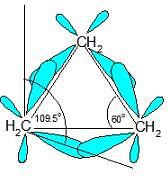
The C-C-C bond angles in cyclopropane (60o) and cyclobutane (90o) are much different than the ideal bond angle of 109.5o.This bond angle causes cyclopropane and cyclobutane to have a high ring strain. However, molecules, such as cyclohexane and cyclopentane, would have a much lower ring strain because the bond angle between the carbons is much closer to 109.5o.

The C-C-C bond angles in cyclopropane (60o) and cyclobutane (90o) are much different than the ideal bond angle of 109.5o.This bond angle causes cyclopropane and cyclobutane to have a high ring strain. However, molecules, such as cyclohexane and cyclopentane, would have a much lower ring strain because the bond angle between the carbons is much closer to 109.5o.
Aliphatic compound is the other name for- a)Acyclic compounds
- b)Alicyclic compounds
- c)Ring compounds
- d)Closed chain compounds
Correct answer is option 'A'. Can you explain this answer?
Aliphatic compound is the other name for
a)
Acyclic compounds
b)
Alicyclic compounds
c)
Ring compounds
d)
Closed chain compounds

|
Mansi Mukherjee answered |
Open chain compounds or acyclic compounds are otherwise called as aliphatic compounds.
Organic compounds can be classified even based upon the function groups. Identify the one which is not a functional group- a)Isocyanide
- b)Isocyano
- c)Carboxyl
- d)Carbonyl
Correct answer is option 'A'. Can you explain this answer?
Organic compounds can be classified even based upon the function groups. Identify the one which is not a functional group
a)
Isocyanide
b)
Isocyano
c)
Carboxyl
d)
Carbonyl

|
Mansi Mukherjee answered |
Isocyanide is a compound and it is not a functional group.
During estimation of nitrogen present in an organic compound by Kjeldahl’s method, the ammonia evolved from 0.5 g of the compound, neutralized 10 mL of 1 M H2SO4.Find out the percentage of nitrogen in the compound.- a)56 %
- b)51%
- c) 46%
- d) 2 %
Correct answer is option 'A'. Can you explain this answer?
During estimation of nitrogen present in an organic compound by Kjeldahl’s method, the ammonia evolved from 0.5 g of the compound, neutralized 10 mL of 1 M H2SO4.Find out the percentage of nitrogen in the compound.
a)
56 %
b)
51%
c)
46%
d)
2 %

|
Jay Chakraborty answered |
moles of NH3= moles of N= 2 × 10 ×1/1000 = 0.02 moles Mass of N = 0.02 × 14 % = 0.02 x 14 × 100/0.5 = 56%
One molecule of water adds to alkynes on warming with mercuric sulphate and dilute sulphuric acid to form:
- a)Carbonyl compound
- b)Propane
- c)Ethyl free radical
- d)Isopropyl free radical
Correct answer is option 'A'. Can you explain this answer?
One molecule of water adds to alkynes on warming with mercuric sulphate and dilute sulphuric acid to form:
a)
Carbonyl compound
b)
Propane
c)
Ethyl free radical
d)
Isopropyl free radical
|
|
Pooja Mehta answered |
When one molecule of alkynes react with mercuric sulphate and dilute sulphuric acid at 333 K it result into the formation of carbonyl compounds.
Reaction involved:


CH2 = CH – CH = CH – CH3 is more stable than CH3 – CH = C = CH – CH3 because- a)there is resonance in I but not in II
- b)there is tautomerism in I but not in II
- c)there is hyperconjugation in I but not in II
- d)II has more cononical structures than I.
Correct answer is option 'A'. Can you explain this answer?
CH2 = CH – CH = CH – CH3 is more stable than CH3 – CH = C = CH – CH3 because
a)
there is resonance in I but not in II
b)
there is tautomerism in I but not in II
c)
there is hyperconjugation in I but not in II
d)
II has more cononical structures than I.

|
Nikitha Novalene Paul answered |
Whenever alternate double bonds are present that means the molecule is in Resonance! Resonance gives stability to a molecule
The correct statement concerning conformers of 1,2-dichloroethane is- a)it's gauche conformer has higher potential energy than an eclipsed conformer in which H—Cl atoms are eclipsing
- b)syn-periplanar conformer is most stable
- c)increasing temperature decreases dipole moment of 1,2-dichloroethane
- d)the two gauche conformers are enantiomers
Correct answer is option 'D'. Can you explain this answer?
The correct statement concerning conformers of 1,2-dichloroethane is
a)
it's gauche conformer has higher potential energy than an eclipsed conformer in which H—Cl atoms are eclipsing
b)
syn-periplanar conformer is most stable
c)
increasing temperature decreases dipole moment of 1,2-dichloroethane
d)
the two gauche conformers are enantiomers
|
|
Rishabh Malhotra answered |
Option D is correct answer
Which among the following is not an example of alicyclic compound- a)Cyclohexane
- b)Cyclohexene
- c)Tetrahydrofuran
- d)Acetic acid
Correct answer is option 'D'. Can you explain this answer?
Which among the following is not an example of alicyclic compound
a)
Cyclohexane
b)
Cyclohexene
c)
Tetrahydrofuran
d)
Acetic acid

|
Shruti Ahuja answered |
Acetic acid is a linear chain compound (acyclic) and hence it is not an example of ring compound (alicyclic).
Which among these is not associated with aliphatic compounds- a)They contain (4n+2)pi electrons
- b)Contain straight chain compounds
- c)Contain branched chain compounds
- d)Has appropriate number of H-atoms and functional groups
Correct answer is option 'A'. Can you explain this answer?
Which among these is not associated with aliphatic compounds
a)
They contain (4n+2)pi electrons
b)
Contain straight chain compounds
c)
Contain branched chain compounds
d)
Has appropriate number of H-atoms and functional groups

|
Ruchi Basak answered |
The aromatic compounds (4n+2)pi electrons, which comes under the classification of cyclic compounds and hence they are not associated with aliphatic compounds.
Bond formation is:- a)always exothermic
- b)always endothermic
- c)neither exothermic nor endothermic
- d)sometimes exothermic and sometimes endothermic
Correct answer is option 'A'. Can you explain this answer?
Bond formation is:
a)
always exothermic
b)
always endothermic
c)
neither exothermic nor endothermic
d)
sometimes exothermic and sometimes endothermic

|
Ankit Mode answered |
Bond is formed if atoms are getting more stable after bond formation and being stable means less energy state so they release energy while bond formation so it is exothermic process
In which of the following molecules resonance takes place through out the entire system- a)

- b)

- c)

- d)

- e)

Correct answer is option 'B'. Can you explain this answer?
In which of the following molecules resonance takes place through out the entire system
a)

b)

c)

d)
e)

|
|
Adwait Ajit answered |
B is correct because a resonant structure must be conjugated.
In Friedel crafts alkylation and acylation the attacking reagent is an:- a)Electrophile
- b)Nucleophile
- c)Radical
- d)Ionic species
Correct answer is option 'A'. Can you explain this answer?
In Friedel crafts alkylation and acylation the attacking reagent is an:
a)
Electrophile
b)
Nucleophile
c)
Radical
d)
Ionic species

|
Aaditya Ghoshal answered |
A Friedel-Crafts alkylation reaction is an electrophilic aromatic substitution reaction in which a carbocation attacks an aromatic ring with the net result that one of the aromatic protons is replaced by an alkyl group. vinyl and aryl halides cannot be used to form carbocations.
What is the type of hybridisation of each carbon in the compound (CH3)2CO?- a)sp2
- b) sp3, sp
- c) sp3, sp2
- d) sp3
Correct answer is option 'C'. Can you explain this answer?
What is the type of hybridisation of each carbon in the compound (CH3)2CO?
a)
sp
2
b)
sp3, sp
c)
sp3, sp2
d)
sp3

|
Arnav Kulkarni answered |
C in CH3 is sp3 and C of C=O bond is sp2.
Distance moved by the substance from the base line to the distance moved by the solvent from the base line is known as the:- a)Df value
- b)Hf value
- c)Rf value
- d)Tf value
Correct answer is option 'C'. Can you explain this answer?
Distance moved by the substance from the base line to the distance moved by the solvent from the base line is known as the:
a)
Df value
b)
Hf value
c)
Rf value
d)
Tf value

|
Ayush Joshi answered |
The Rf value is defined as the ratio of the distance moved by the solute and the distance moved by the the solvent along the paper, where both distances are measured from the common Origin or Application Baseline, that is the point where the sample is initially spotted on the paper.
 In this molecules, π-electron-density is more on
In this molecules, π-electron-density is more on- a)C1 and C3
- b)C2 and C4
- c)C2 and C3
- d)C1 and C4
Correct answer is option 'B'. Can you explain this answer?
In this molecules, π-electron-density is more on
a)
C1 and C3
b)
C2 and C4
c)
C2 and C3
d)
C1 and C4

|
Sarthak Rajendra Bande answered |
In its resonating structures, C2 and C4 always show π-electron density
Electrophilic addition reactions proceed in two steps. The first step involves the addition of an electrophile. Name the type of intermediate formed in the first step of the following addition reaction. H3C−−−HC = CH2+ H+→?- a)1∘ Carbocation
- b)2∘ Carbanion
- c)2∘ Carbocation
- d)1∘ Carbanion
Correct answer is option 'C'. Can you explain this answer?
Electrophilic addition reactions proceed in two steps. The first step involves the addition of an electrophile. Name the type of intermediate formed in the first step of the following addition reaction.
H3C−−−HC = CH2+ H+→?
a)
1∘ Carbocation
b)
2∘ Carbanion
c)
2∘ Carbocation
d)
1∘ Carbanion

|
Kunal Patel answered |
A secondary carbocation is formed.
The IUPAC name for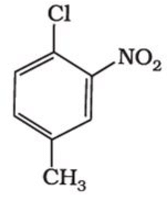
- a)1-Chloro-4-methyl-2-nitrobenzene
- b)2-Chloro-1-nitro-5-methylbenzene
- c)m-Nitro-p-chlorotoluene
- d)1-Chloro-2-nitro-4-methylbenzene
Correct answer is option 'A'. Can you explain this answer?
The IUPAC name for
a)
1-Chloro-4-methyl-2-nitrobenzene
b)
2-Chloro-1-nitro-5-methylbenzene
c)
m-Nitro-p-chlorotoluene
d)
1-Chloro-2-nitro-4-methylbenzene
|
|
Lavanya Menon answered |
1-Chloro-4-methyl-2-nitrobenzene is the iupac name of the given compound.
The correct statement regarding conformation in butane is/are- a)The two gauche forms, when viewed about C2 - C3 bond, are enantiomer
- b)There is greater barrier to rotation about C1 — C2 bond than to C2 - C3 bond
- c)Its gauche form has higher energy than an eclipsed form when CH3 — and 'H' are eclipsing
- d)In the most stable conformer, dihedral angle between hydrogen atoms is only 60°
Correct answer is option 'A,D'. Can you explain this answer?
The correct statement regarding conformation in butane is/are
a)
The two gauche forms, when viewed about C2 - C3 bond, are enantiomer
b)
There is greater barrier to rotation about C1 — C2 bond than to C2 - C3 bond
c)
Its gauche form has higher energy than an eclipsed form when CH3 — and 'H' are eclipsing
d)
In the most stable conformer, dihedral angle between hydrogen atoms is only 60°
|
|
T.ttttt answered |
A) For ethane, there exists three conformational isomers or conformers, which are degenerate because they are congruent. They have the same energy and are same, in all respects.
D) Gauche is the most stable form with less repulsion.
D) Gauche is the most stable form with less repulsion.
Which among the following is not an example of Acyclic compound- a)Acetaldehyde
- b)Ethane
- c)Cyclopropane
- d)Isobutane
Correct answer is option 'C'. Can you explain this answer?
Which among the following is not an example of Acyclic compound
a)
Acetaldehyde
b)
Ethane
c)
Cyclopropane
d)
Isobutane

|
Rithika Mukherjee answered |
Cyclopropane is a ring (cyclic) compound and hence it does not come with the examples of open chain compounds.
Find the odd one among the following:- a)Alicyclic compounds
- b)Heterogeneous compounds
- c)Branched chain compounds
- d)Aromatic compounds
Correct answer is option 'C'. Can you explain this answer?
Find the odd one among the following:
a)
Alicyclic compounds
b)
Heterogeneous compounds
c)
Branched chain compounds
d)
Aromatic compounds

|
Shruti Ahuja answered |
Branched chain compound is a classification of open-chain compounds. Whereas, alicyclic, aromatic and heterogeneous compounds are sub-classifications of cyclic compounds.
In which of the following pairs, first species is more stable than second ?- a)

- b)

- c)

- d)

Correct answer is option 'D'. Can you explain this answer?
In which of the following pairs, first species is more stable than second ?
a)
b)
c)
d)


|
Sakshi Jain answered |
Due to delocalisation of charge at 3 consecutive places and hence more no.of resonating structures.So 'd' is correct option.
C4H10O represents methoxypropane (CH3OC3H7) and ethoxyethane (C2H5O C2H5)- a)Stereoisomerism
- b)Functional group isomerism
- c)Metamerism
- d)isomerism
Correct answer is option 'C'. Can you explain this answer?
C4H10O represents methoxypropane (CH3OC3H7) and ethoxyethane (C2H5O C2H5)
a)
Stereoisomerism
b)
Functional group isomerism
c)
Metamerism
d)
isomerism

|
Anuj Choudhury answered |
rearrangement of carbon atoms around the functional group is known as metamerism.
In which of the following molecels both phenyl rings are not coplanar ?- a)

- b)
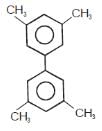
- c)

- d)
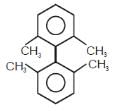
Correct answer is option 'D'. Can you explain this answer?
In which of the following molecels both phenyl rings are not coplanar ?
a)

b)

c)

d)

|
|
Mahanda answered |
Option D is non planar due to steric hindrance at the ortho position.All the other three are co planar.
Which among the following is not a class of organic compound- a)Carbonyl compound
- b)Nitro compound
- c)Amides
- d)Electro compounds
Correct answer is option 'D'. Can you explain this answer?
Which among the following is not a class of organic compound
a)
Carbonyl compound
b)
Nitro compound
c)
Amides
d)
Electro compounds

|
Ishani Mehta answered |
Classes of organic compounds are those which involves organic compounds such as carbon, hydrogen and oxygen. Hence, electro compounds is not a class of organic compounds.
Chapter doubts & questions for Organic Chemistry - Science for ACT 2025 is part of ACT exam preparation. The chapters have been prepared according to the ACT exam syllabus. The Chapter doubts & questions, notes, tests & MCQs are made for ACT 2025 Exam. Find important definitions, questions, notes, meanings, examples, exercises, MCQs and online tests here.
Chapter doubts & questions of Organic Chemistry - Science for ACT in English & Hindi are available as part of ACT exam.
Download more important topics, notes, lectures and mock test series for ACT Exam by signing up for free.
Science for ACT
486 videos|517 docs|337 tests
|
Signup to see your scores go up within 7 days!
Study with 1000+ FREE Docs, Videos & Tests
10M+ students study on EduRev

Contact Support
Our team is online on weekdays between 10 AM - 7 PM
Typical reply within 3 hours
|
Free Exam Preparation
at your Fingertips!
Access Free Study Material - Test Series, Structured Courses, Free Videos & Study Notes and Prepare for Your Exam With Ease

 Join the 10M+ students on EduRev
Join the 10M+ students on EduRev
|

|
Forgot Password
OR
Signup to see your scores
go up within 7 days!
Access 1000+ FREE Docs, Videos and Tests
Takes less than 10 seconds to signup













